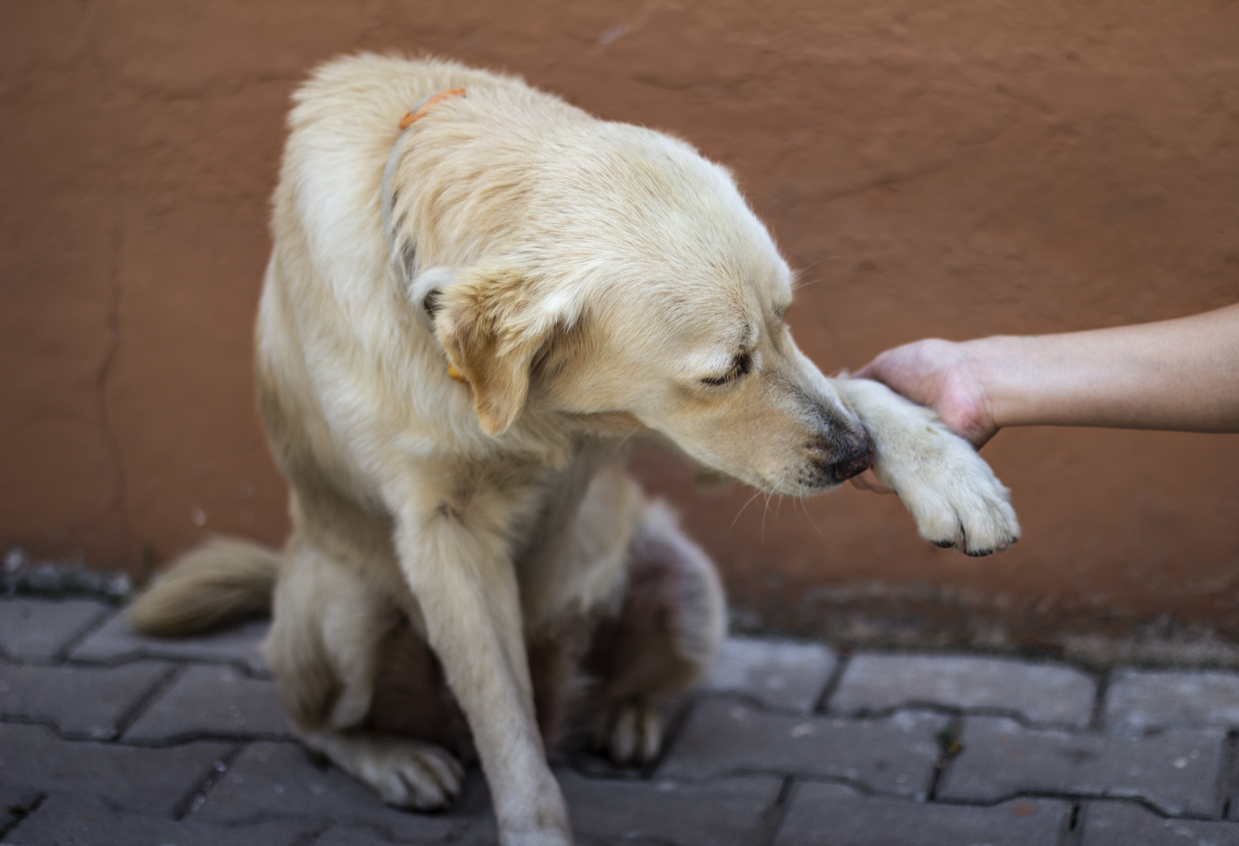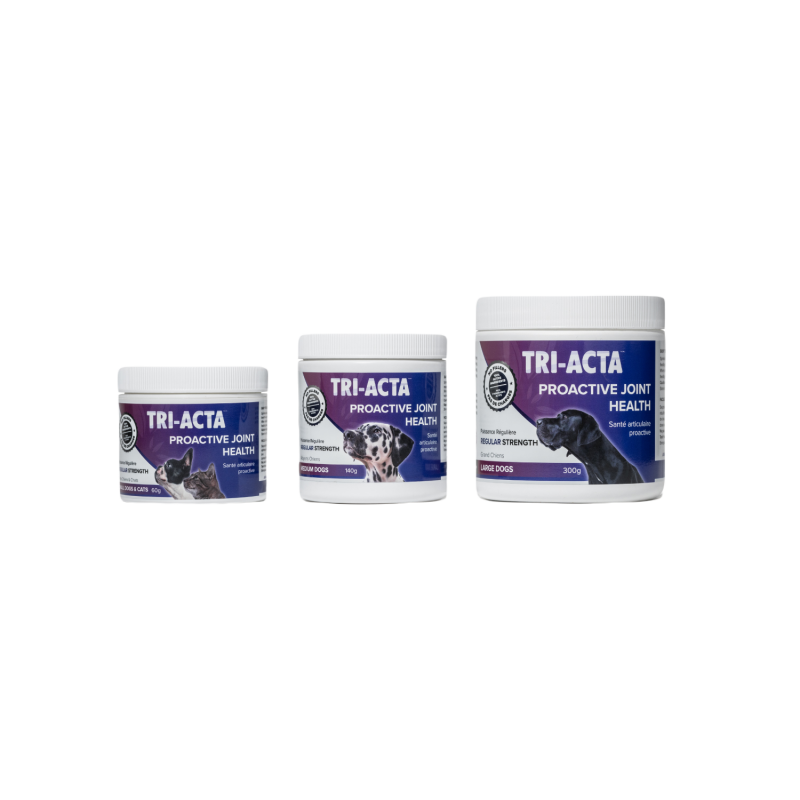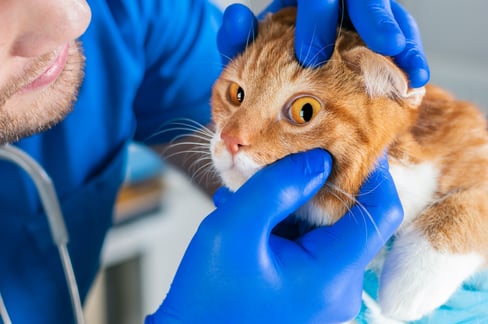Table of Contents
Maybe you’ve experienced the following with your pup: one minute they’re running around, playing with a toy, and the next minute they’re whimpering in pain and licking at their paw.
The likelihood of your pup experiencing a dog paw infection at some point is quite high. Conditions like pododermatitis (inflammation of the skin of the paw) are quite common for veterinarians to deal with. Sometimes, the inflammation can be caused by something obvious, like a stick or bramble stuck in the skin of the paw or a torn nail, but other times the underlying cause of the issue can be hidden—such as a disease, parasite, or other ailment.
This article explores the possible causes, signs, and symptoms of a dog paw infection and provides some insight into treatment options that you or your vet can use to help your pup recover.
Signs and Symptoms of a Dog Paw Infection
Before we get into what you can look for with a dog paw infection, it’s important to know the difference between signs and symptoms.
- Signs are objective—they can be easily observed by anyone and have the severity measured.
- Symptoms are subjective—they’re experienced by the patient (like pain) and are either less obvious or completely undetectable by others.
Examining the signs and symptoms that your pup is experiencing is essential for figuring out what’s affecting your dog’s health.
But we quickly run into a hitch: human patients can tell the doctor where it hurts, the type of hurt, and how much it hurts, but dogs? Not so much. That makes it much harder to tell how serious a condition is in your dog unless you can physically see problems.
Thankfully, there are some visual signs that you can look for to help you determine if your pup is feeling ill. We’ll get into those in the next section, but for now, let’s start by looking at the signs that your pup may have an infection.
Dog Paw Infection Signs
If your dog is experiencing any of the following, their paw (or paws) could be infected and need treatment:
- Licking and chewing paws—If your dog is constantly licking or chewing one or more of their paws, it’s likely a sign that something is bothering them. Dogs instinctively lick and “chew” (more like aggressive licking where they use their teeth and lips to get deeper into the affected area) an injury in an attempt to soothe it, so if they keep going after the same area, it’s a clear indicator that the spot is itchy or painful.
- Redness—Your pup’s skin should be healthy pink or grey. A red or raw patch on their paw that appears raised or bumpy is a sign that the patch of skin could be infected.
- Swelling—If your dog’s paw has raised, red areas that are hot to the touch mean that the area is swollen. You can also compare different paws to see if one looks larger than the other. Swelling is the body’s natural response to an infection as it sends more blood cells to the area in an attempt to control it.
- Cracked and dry paw pads—An obvious sign that something is amiss with your dog’s paw pads is when their skin is dried and cracked. Swelling causes the skin to expand, which can then easily split, especially if your dog licks the area and aggravates the injury. When their saliva dries, pieces of dry, flaky skin are often visible.
- Drainage—Your pup’s body will try to fight the dog paw infection by sending white blood cells to the area, which are special cells that attempt to isolate and destroy the infection. Because of this process, you may notice drainage from the infected wound. If bacteria gets mixed in with the wound because of licking or scratching, the drainage may become worse and appear green or yellow rather than white, which indicates that the infection is worsening.
Dog Paw Infection Symptoms
Of course, your dog can’t tell you how they are feeling, so it can be difficult to determine whether a hurt paw is really bothering them all that much, especially if you can’t see any physical signs of a dog foot infection.
But while your dog can’t speak to you in English, there are other ways they can communicate their discomfort:
- Pain—When your pup is in pain, they will instinctively try to hide it. This is an instinct that they have left over from being in the wild, as an injured dog could compromise the safety of the entire pack by attracting predators. As a result, the other dogs in the pack would abandon the injured dog. Because of this, dogs evolved to hide their pain from others in their family or pack, including you. However, some pain is difficult to hide, especially if it’s severe.
- Behavioural changes—Keep a close eye on your pup for any behavioral changes, as these can signal that something is wrong. Just like people, dogs can get irritable when they don’t feel well. For example, if your pup is typically fine around other dogs and people but is suddenly aggressive when a friend visits, it’s likely a result of the pain and discomfort of their dog paw infection rather than an actual disdain for the individual.
- Lethargy—If your dog typically jumps up excitedly when you mention the word “walk”, but can barely muster up enough energy to lift their head when you get the leash out now, it could mean their body is tired from fighting an infection.
Causes of Infection Dogs Paws

Aside from signs and symptoms of a dog foot infection, knowing the causes of this condition can be helpful for understanding why your pup’s paw isn’t doing so well.
1. Foreign Material Embedded in Skin (Splinter or Burr)
It might seem obvious that if something is embedded in your dog’s paw and left there, it would cause an infection. However, it’s not always easy to spot the culprit; sometimes, a thorn or piece of wood, glass, or metal can be extremely small but still be the underlying cause of a dog paw infection.
If you notice broken skin on your dog’s paw or a pinprick-sized hole, it’s worth investigating to see if they have something stuck inside. If your dog doesn’t want you to touch the area at first because it’s so sensitive, try soaking your dog’s paw in warm (not hot) water to help soothe the skin. With the skin moist and clean from soaking, it might be easier to see if anything is stuck in there. Sometimes objects can be removed with tweezers, but other times, like with a porcupine quill, you may be better off taking your pup to the vet for removal to prevent further injury to the area.
2. Untreated Underlying Disease (Hypothyroidism, Fungal Infection)
Some diseases can be seemingly invisible in the sense that symptoms don’t seem to show until the disease reaches a severe stage. Plus, some diseases can exhibit signs and symptoms that don’t logically correlate with the disease itself—who would have thought that Hypothyroidism, a problem with an organ in your dog’s neck, can cause skin issues, including on their paws?
It’s true, though—hypothyroidism can cause ailments like hot spots, which are raw, red, and itchy patches that can present on your dog’s legs, paw pads, legs, ears, or back. This is because the lack of hormones that the thyroid produces affects the functioning of all organs in your dog’s body, including their skin. Areas of high wear are especially susceptible to issues with increased pigmentation, hair loss, and less tolerance to cold and heat.
Fungal infections are another common issue that can potentially cause a dog paw infection between toes. All animals have yeast—a type of usually beneficial bacteria—on their skin at all times. Sometimes, the number of yeast gets too high, which causes an infection due to trapped moisture. In between your dog’s toes and in their skin folds is a great place for moisture to get trapped at the best of times, so yeast fungal infections tend to thrive in these areas. Interestingly, yeast infections can be a sign of hypothyroidism in dogs, but it can also indicate conditions like cancer, auto-immune disease, or allergies.
3. Parasites
Parasitic demodex pododermatitis is a condition where unwelcome guests set up camp on your dog’s paws, resulting in painful sores and infected skin. Demodex mites are the most common parasite, as they naturally live on your dog’s hair follicles. Typically, the mites transfer from mother to puppy during nursing, so the condition is often found in puppies. However, the condition is usually minor and can be resolved without treatment. Like yeast, every dog has Demodex mites, which are usually beneficial.
When too many mites are present, your dog’s body can usually fight them off just fine, but if your pup’s immune system is compromised, the mites multiply too quickly, resulting in hair loss and itchy patches of skin. The type of demodex that affects your dog’s paws and results in a dog paw infection usually causes a secondary bacterial infection, which is tougher to cure than a demodex that occurs on another part of your dog’s body.
A veterinarian can diagnose Demodex pododermatitis by taking a sample of your dog’s skin and looking at it under a microscope to see if the mites are present.
4. Burns
Another affliction that can result in a dog foot infection is a burn. You might not think that it could be easy for your pup to get a burn on their paws, but it’s more common than you think. Pavement and asphalt are excellent heat absorbers, so when it’s really hot outside, and you want to take your dog out for a walk, it’s important to think twice. The heat will be tough to deal with, and hot surfaces can burn your dog’s paw pads.
Before you take your dog out for a walk in the heat, there are a few things to be mindful of:
- The heat of sidewalks and roadways. Before you let your pup step on a hot sidewalk or road, take the back of your hand and lightly touch it to the surface. If you pull away quickly because it’s too hot for you to handle, it’s too hot for your pooch!
- Walking your dog on grass instead of the road or sidewalk. Grass absorbs some heat, but it also remains a lot cooler in hot weather. Consider taking your pup to a dog park or walking them in an area with plenty of grass and trees for shade (don’t forget to bring plenty of water!)
- Walk your dog in the morning or evening when it’s cooler outside. Of course, you don’t have to take your dog out for a walk in the middle of the day when it’s hottest outside; you can change up your routine to take them for a walk when the temperature is a bit more bearable.
- Consider indoor activities instead. Sometimes, the outdoors are just too hot to handle. Entertaining your dog and burning their energy through indoor-friendly activities, like lick mats, tug-o-war, and puzzle toys, is sometimes better than a walk in the heat.
5. Joint Issues
Any kind of lame dog issues that cause uncoordinated movement can mean a higher chance of torn toenails or potentially breaking or spraining a toe, which can lead to an infection. Joint issues are extremely common in both purebred and mixed dog breeds. One of the ways that you can help ensure that your dog’s joints remain strong as they age is by giving them a joint supplement.
TRI-ACTA is a great choice for a preventative joint supplement that you can start giving your dog from the time they are a puppy right into adulthood. It contains all-natural ingredients that promote your dog’s joint health, including glucosamine for dogs, chondroitin (essential for cartilage regeneration and protection), and MSM (a natural anti-inflammatory).
For pups that need a bit more help with their joints, our extra-strength TRI-ACTA H.A. is also available and includes the above ingredients as well as hyaluronic acid, which improves the viscosity of synovial fluid (lubricant) in your dog’s joints, allowing for easier movement.
TRI-ACTA H.A. for Pets
Our maximum strength formula is optimally designed to accelerate the formation of cartilage, minimize inflammation, expedite the healing process, and improve joint conditions.

Types of Infection in Dogs Paw
Different types of infections can occur in your dog’s paws:
1. Nail Problems
If your dog’s nails don’t grow correctly, they can easily cause secondary problems that affect their paws. Ingrown toenails can penetrate the skin on your dog’s paws and cause painful sores, which can, in turn, get infected rather quickly since your dog’s paws are always touching the dirty ground.
In addition to ingrown toenails, another common nail issue for dogs that can result in a dog paw infection is torn nails or ripped nails. It’s easy for a dog to accidentally tear a nail if they are running on a slippery surface and catch their nail when they try to stop. Making sure your dog’s nails are trimmed and putting down rugs on slippery floors are two preventative measures that you can take.
2. Allergies
Sometimes, allergic reactions can present as skin irritation. Food allergies, for example, can sometimes cause hot spots, which we mentioned earlier, are commonly found on the paws. These raw, itchy patches can get worse with repeated licking and scratching. Topical ointment and investigation into what’s causing your pup’s allergies are paramount for prevention.
3. Bacterial and Skin Infections
Infections in the skin can be caused by a variety of ailments and are usually a secondary effect of untreated disease. Common diseases that can result in a dog paw infection include:
- Yeast, fungus, and parasites
- Immune system deficiency
- Hyperthyroidism or hypothyroidism
- Tumours
- Contact dermatitis (a blanket term for any sort of skin irritation caused by trauma, burns, or foreign bodies entering the skin)
4. Dog Paw Infection Between Toes
A common cause of a dog paw infection between toes is Interdigital furuncle—painful, pus-filled blisters that often occur in the webbing between a dog’s toes. A bacterial infection often causes this condition.
Breeds Predisposed to a Dog Paw Infection Between Toes:
- Any dog with short hair shafts between their toes
- Chinese Sharpeis
- Labrador Retriever
- English Bulldogs
Sometimes, using antibiotics improperly can lead to recurring furuncles. It’s important that you give your dog the full dose of antibiotics as prescribed by your vet, and don’t stop giving the medication just because your dog appears better. In addition, only getting antibiotics from your vet and not attempting to treat your dog’s condition yourself by purchasing antibiotics from elsewhere is important.
How to Treat Dog Paw Infection at Home
In some cases, you might be able to treat your dog’s infection yourself. The table below outlines some ways to treat dog paw infection at home:
|
Home Treatment Option |
Instructions |
|
Washing your dog’s paw with soap and water |
|
|
Dog paw soak for infection |
There are a few options for making a DIY dog paw soak for infection:
|
|
Apply ointment to create a soothing moisture barrier |
|
Dog Paw Infection Treatment Side Effects
Aside from home remedies, it’s sometimes necessary for your dog to get veterinary treatment for their infected paw. Your vet may prescribe antibiotics and/or NSAIDs (non-steroidal anti-inflammatory drugs) as part of a dog paw infection treatment regime.
When you give your dog these drugs, it’s important to know the potential side effects:
- Antibiotics can affect your dog’s gut health by causing upset stomach symptoms such as vomiting and diarrhea. Usually, these symptoms resolve on their own, but if they persist, you should contact your vet.
- NSAIDs are usually fine for short-term use, but the longer your dog takes them, the more risk they have for stomach ulcers as well as liver and kidney damage.
Best Antibiotic for Dog Paw Infection
There are several antibiotics that your vet may recommend to treat a dog paw infection. Because a dog paw infection is often caused by bacteria such as Staphylococcus pseudintermedius, a broad-spectrum antibiotic is often the first choice.
These antibiotics are outlined in the table below:
|
Antibiotic Type |
Names |
|
Oral antifungal medication |
These medications are often used alongside topical treatment, like an antifungal dog shampoo for maximum effect. |
|
Cream or ointment |
|
|
Oral antibiotics |
|
How to Prevent Infection on Dogs Paw
Preventing an infection on dogs paw is important to make sure that your dog has the best chance of not experiencing this painful affliction. Here are some tips you can follow:
- Place area rugs or carpets on slippery floors.
- Check concrete before walking dogs on hot days, and either walk them in the grass instead, walk them in the morning or evening when it’s cooler, or keep them inside.
- Use dog shoes when walking your dog in winter to prevent exposure to road salt (can chemically burn paws).
- Be mindful of nails, screws, and other objects on your property that could become lodged in your dog’s paws, causing a sore or cut that could lead to an infection.
- Keep your dog’s nails trimmed to help prevent long nails from getting caught on surfaces as they walk and break.
Summary
Making sure your dog’s paws are in tip-top condition is extremely important for their overall well-being. From giving your dog joint supplements to keep the bones in their feet strong to providing them with antibiotics and topical creams when they do injure their little digits, there are thankfully many ways that you can ensure that your dog recovers from a dog paw infection and gets back to playing and running around in no time at all.
If you’re looking for a joint supplement to support your dog’s joints from their neck to their toes, consider TRI-ACTA. Made with 100% natural ingredients and Health Canada-approved, you can be sure you’re giving your pup the good stuff.
Buy TRI-ACTA online today or find out where to buy in stores.
TRI-ACTA for Pets
A proactive approach for developing and younger adult pets to maintain optimal joint health mobility, minimize inflammation and fend off age-related ailments.

Newsletter Signup
Subscribe to our newsletter to receive the latest news and exclusive offers.
.jpg?height=2000&name=Cliick_Integricare-DISPLAY-REVISEDV2%20(1).jpg)
Proactive & Therapeutic Joint Supplements
When given daily, Integricare joint supplements recover bone and joint injuries faster and help prevent mobility injuries from happening in the first place.

.jpg)









